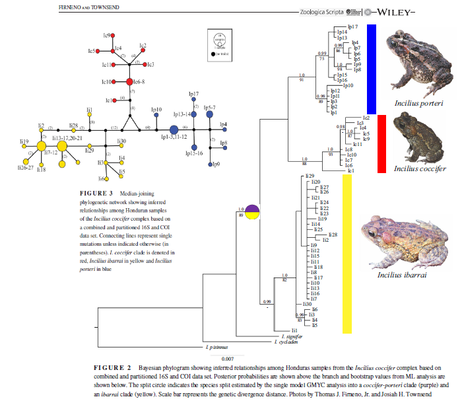Evolution of Mesoamerican Upland Toads

Integrative evaluation of species boundaries in sympatric and parapatric populations of Mesoamerican toads (Bufonidae: Incilius coccifer group)
Firneno, Jr., TJ, and JH Townsend. 2019. Zoologica Scripta 48(4): 454–465. Download here
The first comprehensive evaluation of a taxonomically-debated complex of Mesoamerican highland toads was published by Firneno and Townsend in a recent issue of the journal Zoologica Scripta. The Incilius coccifer complex in Honduras is comprised of three putative taxa: I. coccifer, I. ibarrai and I. porteri. The taxonomy of the I. coccifer complex has been a source of debate among specialists, with some recognizing three species, while others choose to recognize one widespread taxon. To assess species boundaries and evaluate the taxonomic structure for the I. coccifer complex, we utilized a combination of comprehensive field sampling, molecular phylogenetics and macroecological modelling. Using 58 samples representing all three putative taxa, we generated sequence data from the mitochondrial loci 16S and COI in order to assess genetic diversity and phylogenetic relationships, and tested putative species boundaries using General Mixed Yule‐Coalescent models. To evaluate macroecological differences in the distribution of putative taxa, we utilized maximum entropy modelling and identified areas of suitable and non‐suitable habitat, as well as identifying potential areas of overlap between species habitats. We recovered three clades that broadly correspond to the three named taxa that, while being monophyletic, are separated by relatively small genetic distances. Species distribution models revealed that I. coccifer is macroecologically different than the other two taxa, but that I. ibarrai and I. porteri are highly similar. We uncovered cases of sympatry between pairs of species in at least three localities in Honduras, suggesting the potential for hybridization in these closely related lineages.
Firneno, Jr., TJ, and JH Townsend. 2019. Zoologica Scripta 48(4): 454–465. Download here
The first comprehensive evaluation of a taxonomically-debated complex of Mesoamerican highland toads was published by Firneno and Townsend in a recent issue of the journal Zoologica Scripta. The Incilius coccifer complex in Honduras is comprised of three putative taxa: I. coccifer, I. ibarrai and I. porteri. The taxonomy of the I. coccifer complex has been a source of debate among specialists, with some recognizing three species, while others choose to recognize one widespread taxon. To assess species boundaries and evaluate the taxonomic structure for the I. coccifer complex, we utilized a combination of comprehensive field sampling, molecular phylogenetics and macroecological modelling. Using 58 samples representing all three putative taxa, we generated sequence data from the mitochondrial loci 16S and COI in order to assess genetic diversity and phylogenetic relationships, and tested putative species boundaries using General Mixed Yule‐Coalescent models. To evaluate macroecological differences in the distribution of putative taxa, we utilized maximum entropy modelling and identified areas of suitable and non‐suitable habitat, as well as identifying potential areas of overlap between species habitats. We recovered three clades that broadly correspond to the three named taxa that, while being monophyletic, are separated by relatively small genetic distances. Species distribution models revealed that I. coccifer is macroecologically different than the other two taxa, but that I. ibarrai and I. porteri are highly similar. We uncovered cases of sympatry between pairs of species in at least three localities in Honduras, suggesting the potential for hybridization in these closely related lineages.
